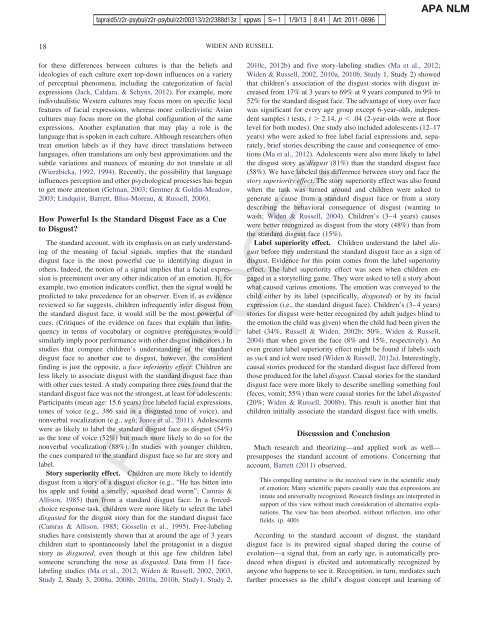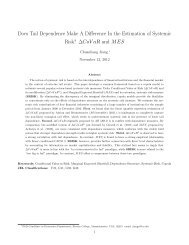Children's Recognition of Disgust in Others - Boston College
Children's Recognition of Disgust in Others - Boston College
Children's Recognition of Disgust in Others - Boston College
You also want an ePaper? Increase the reach of your titles
YUMPU automatically turns print PDFs into web optimized ePapers that Google loves.
tapraid5/z2r-psybul/z2r-psybul/z2r00313/z2r2388d13z xppws S1 1/9/13 8:41 Art: 2011-0696APA NLM18 WIDEN AND RUSSELLfor these differences between cultures is that the beliefs andideologies <strong>of</strong> each culture exert top-down <strong>in</strong>fluences on a variety<strong>of</strong> perceptual phenomena, <strong>in</strong>clud<strong>in</strong>g the categorization <strong>of</strong> facialexpressions (Jack, Caldara, & Schyns, 2012). For example, more<strong>in</strong>dividualistic Western cultures may focus more on specific localfeatures <strong>of</strong> facial expressions, whereas more collectivistic Asiancultures may focus more on the global configuration <strong>of</strong> the sameexpressions. Another explanation that may play a role is thelanguage that is spoken <strong>in</strong> each culture. Although researchers <strong>of</strong>tentreat emotion labels as if they have direct translations betweenlanguages, <strong>of</strong>ten translations are only best approximations and thesubtle variations and nuances <strong>of</strong> mean<strong>in</strong>g do not translate at all(Wierzbicka, 1992, 1994). Recently, the possibility that language<strong>in</strong>fluences perception and other psychological processes has begunto get more attention (Gelman, 2003; Gentner & Gold<strong>in</strong>-Meadow,2003; L<strong>in</strong>dquist, Barrett, Bliss-Moreau, & Russell, 2006).How Powerful Is the Standard <strong>Disgust</strong> Face as a Cueto <strong>Disgust</strong>?The standard account, with its emphasis on an early understand<strong>in</strong>g<strong>of</strong> the mean<strong>in</strong>g <strong>of</strong> facial signals, implies that the standarddisgust face is the most powerful cue to identify<strong>in</strong>g disgust <strong>in</strong>others. Indeed, the notion <strong>of</strong> a signal implies that a facial expressionis preem<strong>in</strong>ent over any other <strong>in</strong>dication <strong>of</strong> an emotion. If, forexample, two emotion <strong>in</strong>dicators conflict, then the signal would bepredicted to take precedence for an observer. Even if, as evidencereviewed so far suggests, children <strong>in</strong>frequently <strong>in</strong>fer disgust fromthe standard disgust face, it would still be the most powerful <strong>of</strong>cues. (Critiques <strong>of</strong> the evidence on faces that expla<strong>in</strong> that <strong>in</strong>frequency<strong>in</strong> terms <strong>of</strong> vocabulary or cognitive prerequisites wouldsimilarly imply poor performance with other disgust <strong>in</strong>dicators.) Instudies that compare children’s understand<strong>in</strong>g <strong>of</strong> the standarddisgust face to another cue to disgust, however, the consistentf<strong>in</strong>d<strong>in</strong>g is just the opposite, a face <strong>in</strong>feriority effect: Children areless likely to associate disgust with the standard disgust face thanwith other cues tested. A study compar<strong>in</strong>g three cues found that thestandard disgust face was not the strongest, at least for adolescents:Participants (mean age: 15.6 years) free labeled facial expressions,tones <strong>of</strong> voice (e.g., 386 said <strong>in</strong> a disgusted tone <strong>of</strong> voice), andnonverbal vocalization (e.g., ugh; Jones et al., 2011). Adolescentswere as likely to label the standard disgust face as disgust (54%)as the tone <strong>of</strong> voice (52%) but much more likely to do so for thenonverbal vocalization (88%). In studies with younger children,the cues compared to the standard disgust face so far are story andlabel.Story superiority effect. Children are more likely to identifydisgust from a story <strong>of</strong> a disgust elicitor (e.g., “He has bitten <strong>in</strong>tohis apple and found a smelly, squashed dead worm”; Camras &Allison, 1985) than from a standard disgust face. In a forcedchoiceresponse task, children were more likely to select the labeldisgusted for the disgust story than for the standard disgust face(Camras & Allison, 1985; Gossel<strong>in</strong> et al., 1995). Free-label<strong>in</strong>gstudies have consistently shown that at around the age <strong>of</strong> 3 yearschildren start to spontaneously label the protagonist <strong>in</strong> a disguststory as disgusted, even though at this age few children labelsomeone scrunch<strong>in</strong>g the nose as disgusted. Data from 11 facelabel<strong>in</strong>gstudies (Ma et al., 2012; Widen & Russell, 2002, 2003,Study 2, Study 3, 2008a, 2008b, 2010a, 2010b, Study1, Study 2,2010c, 2012b) and five story-label<strong>in</strong>g studies (Ma et al., 2012;Widen & Russell, 2002, 2010a, 2010b, Study 1, Study 2) showedthat children’s association <strong>of</strong> the disgust stories with disgust <strong>in</strong>creasedfrom 17% at 3 years to 69% at 9 years compared to 9% to52% for the standard disgust face. The advantage <strong>of</strong> story over facewas significant for every age group except 6-year-olds, <strong>in</strong>dependentsamples t tests, t 2.14, p .04 (2-year-olds were at floorlevel for both modes). One study also <strong>in</strong>cluded adolescents (12–17years) who were asked to free label facial expressions and, separately,brief stories describ<strong>in</strong>g the cause and consequence <strong>of</strong> emotions(Ma et al., 2012). Adolescents were also more likely to labelthe disgust story as disgust (81%) than the standard disgust face(58%). We have labeled this difference between story and face thestory superiority effect. The story superiority effect was also foundwhen the task was turned around and children were asked togenerate a cause from a standard disgust face or from a storydescrib<strong>in</strong>g the behavioral consequence <strong>of</strong> disgust (want<strong>in</strong>g towash; Widen & Russell, 2004). Children’s (3–4 years) causeswere better recognized as disgust from the story (48%) than fromthe standard disgust face (15%).Label superiority effect. Children understand the label disgustbefore they understand the standard disgust face as a sign <strong>of</strong>disgust. Evidence for this po<strong>in</strong>t comes from the label superiorityeffect. The label superiority effect was seen when children engaged<strong>in</strong> a storytell<strong>in</strong>g game. They were asked to tell a story aboutwhat caused various emotions. The emotion was conveyed to thechild either by its label (specifically, disgusted) or by its facialexpression (i.e., the standard disgust face). Children’s (3–4 years)stories for disgust were better recognized (by adult judges bl<strong>in</strong>d tothe emotion the child was given) when the child had been given thelabel (34%, Russell & Widen, 2002b; 50%, Widen & Russell,2004) than when given the face (8% and 15%, respectively). Aneven greater label superiority effect might be found if labels suchas yuck and ick were used (Widen & Russell, 2012a). Interest<strong>in</strong>gly,causal stories produced for the standard disgust face differed fromthose produced for the label disgust. Causal stories for the standarddisgust face were more likely to describe smell<strong>in</strong>g someth<strong>in</strong>g foul(feces, vomit; 55%) than were causal stories for the label disgusted(20%; Widen & Russell, 2008b). This result is another h<strong>in</strong>t thatchildren <strong>in</strong>itially associate the standard disgust face with smells.Discussion and ConclusionMuch research and theoriz<strong>in</strong>g—and applied work as well—presupposes the standard account <strong>of</strong> emotions. Concern<strong>in</strong>g thataccount, Barrett (2011) observed,This compell<strong>in</strong>g narrative is the received view <strong>in</strong> the scientific study<strong>of</strong> emotion: Many scientific papers casually state that expressions are<strong>in</strong>nate and universally recognized. Research f<strong>in</strong>d<strong>in</strong>gs are <strong>in</strong>terpreted <strong>in</strong>support <strong>of</strong> this view without much consideration <strong>of</strong> alternative explanations.The view has been absorbed, without reflection, <strong>in</strong>to otherfields. (p. 400)Accord<strong>in</strong>g to the standard account <strong>of</strong> disgust, the standarddisgust face is its prewired signal shaped dur<strong>in</strong>g the course <strong>of</strong>evolution—a signal that, from an early age, is automatically producedwhen disgust is elicited and automatically recognized byanyone who happens to see it. <strong>Recognition</strong>, <strong>in</strong> turn, mediates suchfurther processes as the child’s disgust concept and learn<strong>in</strong>g <strong>of</strong>
















